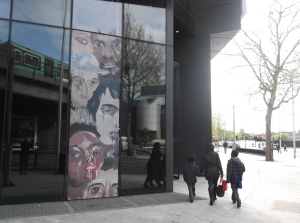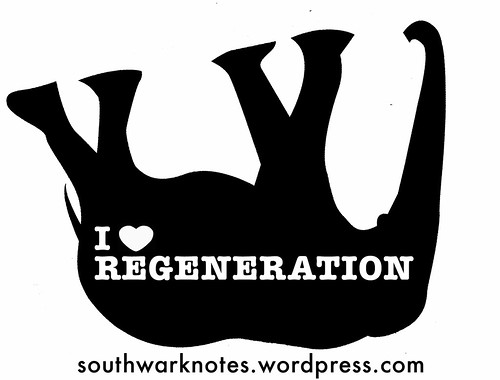Way back in the day of 2006, our tired eyes at Southwark Notes perked up when, on reading the very exciting Section 106 Agreement between Southwark Council and Castle House Developers Ltd, we spotted the following clause:
“8 – PUBLIC ART
8.1: Prior to Occupation, the Developer will commission and install within the Development the Public Art. The value of the Public Art (including the cost of installation) shall be approximately £100,000
Strata Section 106 Agreement PUBLIC ART (definition): A work of art to be installed within the entrance area of the Development predominantly of glass unless otherwise agreed. ”
As you probably know Section 106 (S106) agreements are more commonly known as ‘planning gain’ or ‘community benefits’. An S106 agreement between a developer and a Council usually acts as some kind of payback from the profits the developer will make on their new building towards local good. Examples from a S106 agreement could be that money is negotiated for the renovation of a local children’s playground or that monies are given over to the funding of a community health centre or that cash is given up to supplement the construction of ‘affordable’ housing units.
In this instance, the Strata developers Brookfield Multiplex, as part of their S106 Agreement with the Council, had gone down the well-trodden ‘Public Art as Community Benefit garden path’ and promised to us locals that £100,000 pounds of their profits would bring us some culture. Now, Southwark Notes loves as much Public Art as the next person (see here for our appreciation) but we immediately sniffed out that there was something well iffy about this one!
First and foremost there is the question of what is public art and what isn’t? The original intention of Brookfield was to install something arty ‘within the entrance area of the Development predominantly of glass‘. Something sculptural made of glass put in the actual public realm of The Elephant isn’t going to last the half hour so we can only read this line as meaning spending £100,000 on a fancy glass thing in the foyer of your building. That’s having your glass cake and eating it. In the end, the fabled thing ‘predominantly of glass‘ bit the dust and by 2010, the Public Art had turned into a much more slippery and dubious affair.


Screenshot from Brookfield’s now offline StrataLondonArt.com site, 2010
WHOSE ART IS IT ANYWAY?
With some fanfare typical of developers, by April 2010, the Public Art had mutated into a whole new bag of tricks. With the intention of adding the usual ‘vibrancy‘ to the local area and ‘support and developing local talent‘, Brookfield announced that the public art at Strata would now come from a competition held amongst students at Camberwell College of Art. They announced that the art would now be fixed up on ‘either side of the main entrance doors to Strata‘ and that the art would be housed on ‘two large glass panels enclosing the foyer area‘. Such art would be ‘integral to the development but accessible to the public eye at all times‘ as ‘these panels formed the ideal palette for the Public Art‘.
Essentially this is another version of the ‘predominantly‘ glass thing that never was. Southwark Notes would argue that any art ‘integral‘ to the development i.e constructed as part of the entrance is not a genuinely public piece of art regardless of whether it can be seen by the public. We would call that a design feature of Strata that benefits residents and potential buyers of the flats. If everyone at Southwark Notes painted their front door’s green with yellow spots, we would not argue that this was done for the public benefit. Any public enjoyment of our yellow spots is purely secondary.

WHOSE S106 MONEY IS IT ANYWAY?
36 Camberwell students submitted works to the competition on the theme of what Brookfield told us was ‘’community and sustainable leaving’. Surely a Freudian slip if ever there was one! On 19 May 2010, ‘a panel of four judges shortlisted 13 pieces as finalists to be created and then the finished artworks were judged and on 24 June 2010 six bursaries were awarded to the winning students‘. Over the course of the next year, four artworks were displayed on the glass panels on either side of the entrance foyer.
On July 1st 2010, at the official launch of Strata Tower as an investment and housing option, all the finalist works were exhibited in the empty commercial space at Strata ground floor. Brookfield reported that ‘all finalists’ work…was then auctioned. All monies raised from the action went back to the community and the Camberwell College of Arts‘. Here and subsequently as you will see, it has not been possible to find out how and also how much money went back into the community.
Curious as we were with this strange tale, we decided to submit a Freedom of Information Request (FOI) to Southwark Council to ask them details of how £100,000 of S106 money negiotiated for local benefit was spent. We couldn’t see how four panels displayed throughout one year could add up to such a large figure. We were also concerned that the public art was not really public at all.
THE LONG WAIT FOR WHAT WE ALREADY KNEW
On 1st Febraury 2012, we sent off our simple FOI request:
“Can the Council show a breakdown of total expenditure so far for the Strata Tower S106 contribution of £100,000 towards a public art commission“.
On March 20th 2012 we received a detailed reply that told us that ‘The Council can confirm that Clause 8.1 of the section 106 agreement has now been fully complied with“. The Council reckoned that the ‘set up cost and judging panel for this public art programme included bursaries; artwork reproduction; exhibition set up cost and consultant fees‘ added up to £100,000 well spent. The Council even stated that ‘the installation costs, the public art programme and the value of the artwork itself together can be attributed a value which is in excess of the £100.000 required by the S106 agreement‘. Firstly we wondered whether the undefinable value of an artwork can be considered as part of a financial contribution to the local community. We also thought that it didn’t sound like £100,000 had been spent for the local community. As S106 is serious financial agreement between parties, we wrote again asking that the Council provides a breakdown of expenditure for this S106 contribution. We wanted figures for how much each bursary was, how much consultants were paid, costs of installation and production of artworks etc.


Alina Petrenko’s winning design up on Strata 2010
To try and cut a very long story short, we wrote again for this expenditure on March 8th 2o12. The Council said they didn’t have the information and maybe DP9 had it. DP9 is a partner planning consultant on Strata development. We asked for names at DP9 to write to but got no reply. By May 2012, we requested an Internal Review on this matter as no further information on the expenditure had come our way from The Council. We wrote that the request for an “internal review is based upon asking whether the Council, after securing £100,000 Section 6 money for public art, is able to then account for the expenditure of this money“.
In June 2012, the Council assured us that ‘this obligation was monitored in the same way it would be for any other non-payment s106 obligation and is satisfied the obligation in the provision of the public art worth £100,000 has been provided. We have requested further information from the development and will pass that on in due course‘. Nothing was heard so in August 2012, we requested another Internal Review.
GOING NOWHERE FAST
Dodging the request for the Review, the Council replied in September 2012 that
‘with regard to the process for confirming the S106 condition for public art at the Strata Tower, I can confirm that upon investigation the confirmation of the fulfilled condition was undertaken by the then S106 officer. This process involved receiving confirmation from the developer that the funds had been transferred together with confirmation from the college that the funds had been received. The college also confirmed how the funds were spent, which was provided in the original response to your request. The council confirms that in this instance a site visit from an officer did not take place and on reflection, a site visit should have been conducted, but due to resource constraints and the fact both the college and developer confirmed the fulfilment of this obligation, the council was satisfied that this met the condition as set out in the S106 agreement‘.
We can summarise this as Council S106 Officer asks developer if they done what they supposed to do and developer says ‘Hell yeah!‘. Council Officer says ‘should do a site visit but couldn’t be bothered‘. Council says ‘yeah, we should have done a site visit but we didn’t‘. In light of this fact, the Council says “In order to complete the council records in relation to this agreement, I can confirm that the S106 manager is still seeking this information” which seems like an admission that some major slackness is taking place.
As no actual expenditure figures have been received despite what the Council reply says, we wrote again in November 2012 asking for another Internal Review and then we heard nothing. In February 2013 we wrote again ‘Happy Birthday! We are 1 year old today! Do you think you will ever be able to answer my request for a proper breakdown of all expenditure relating to the S106 Public Art at Strata Building that I submitted on 1st Feb 2012?’
I.C.O – A-GO-GO!
In March 2013, we took the next step after the failure to gain an Internal Review and wrote about this case to the Information Commissioner’s Office, the folks who are ‘the UK’s independent authority set up to uphold information rights in the public interest, promoting openness by public bodies and data privacy for individuals‘.
In May 2013, prompted by the weak boot of the ICO, the Council finally sends us a reply in which they pointlessly re-send to us the original reply they made to us in March 2012 saying again that this provides the info they have. They then write what we knew all along that:
‘I can confirm the council conducted a search of its records at the time of the first request and established that a full breakdown of the information was not held by the council…As a final response, the council is able to confirm we do not hold a breakdown of the information that has been requested and all information held in relation to this request has now been provided’.
Which is a brilliant way of saying ‘we have supplied you with the information that we do not have’!
We replied with an leaving salvo:
“Dear Regeneration & Neighbourhoods,
Thank you for the update and the letter from DP9 both of which confirm that the Council does not know how £100,000 of Section 106 money was spent. As S106 monies are negotiated by councils from developers profits to be used to benefit the local community, it is vital that such money can be accounted for if local people are to have any trust that the council is looking after their interest”.
IF WE GAVE YOU £100,00, WOULD YOU KEEP AN EYE ON IT?
As we write this, the overall winner of the competition Julie Bennett still has her panel displayed at the front of the Strata Tower despite her expectation that it would be displayed only ‘until 30th June 2011‘. We found out that the bursaries to the four winning students were only £1000 quid each. Here, as we scratch our weary heads, we can’t see that this is a genuinely spent £100,000 of community benefit!
We also wonder if the publicised Brookfield Trust that the developer was to set up at Camberwell from money raised at the Strate Official Launch auction to provide more bursaries ever materialised. We were certainly unable to see this in action when we asked and searched around. The website Stratalondonart.com which featured this claim and all the winning designs and promotional guff for Brookfield’s heavy interest in art was only online for one year from June 2010 to Sept 2011 before getting the boot. We also question the dubious practice of getting students involved in the dodgy regeneration practice of designing decorative panels that act as an asset to developments whilst pretending to be pieces of public art.
—

The whole sorry saga can be found here in the form of letters from us to the Council and the letters from the Council to us.
August 2018: Nothing exists of any public art at Strata now begging the question where did the money go?











